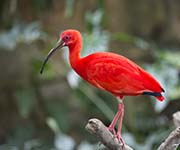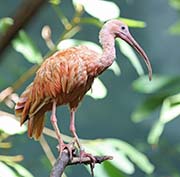Scarlet Ibis - Eudocimus ruber
| Length | |
| Wingspan | |
| Weight | |
| Clutch Size | |
| Chicks at birth | |
| IUCN Conservation Status | |
Continents: |
The Scarlet Ibis is a wading bird and it is closely related to the American White Ibis. They may even be in the same species since there are reports that they have bred together and produced chicks that have salmon or pink adult plumage.
The Scarlet Ibis is easily recognized because of its scarlet plumage which gets brighter as they age. Their wingtips are black, their legs and feet pink. Their nostrils are at the base of their bill which allows them to breathe as they stick their bill in water or mud. Scarlet Ibises are social birds and are found in large flocks.
Juveniles are grey, brown and white. As they grow, the pigments from eating red crustaceans produces the scarlet plumage. Females are slightly smaller than the males.








